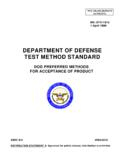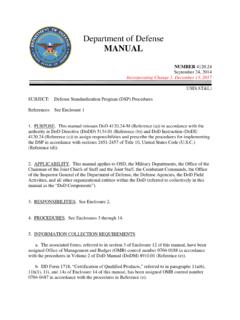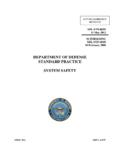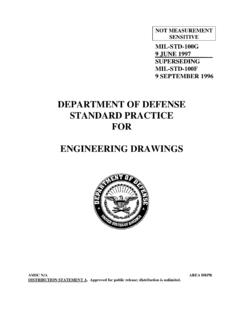Transcription of DEPARTMENT OF DEFENSE HANDBOOK …
1 NOT MEASUREMENT. SENSITIVE. MIL-HDBK-1916. 10 February 1999. DEPARTMENT OF DEFENSE . HANDBOOK . companion document . TO MIL-STD-1916. This HANDBOOK is for guidance only. Do not cite this document as a requirement. AMSC N/A AREA QCIC. MIL-HDBK-1916. FOREWORD. 1. This HANDBOOK is approved for use by all Departments and Agencies of the DEPARTMENT of DEFENSE . This document provides guidance on the use of MIL-STD-1916 to DEFENSE contractors and other commercial organizations supplying goods and services to the Government. The most significant difference between MIL-STD-1916 and previous product acceptance Military Standards is its emphasis on process-oriented improvement efforts. MIL-STD-1916 promotes the use of alternate methods of acceptance to sampling, and specifically endorses the implementation and use of a statistical process control (SPC) program.
2 In compliance with DoD procurement quality strategy, MIL-STD-1916 emphasizes prevention. Furthermore, MIL-STD-1916 allows freedom on the part of suppliers to develop, plan, and implement their own quality system in so far as it is prevention-oriented and founded on the principles of continuous improvement of process and product quality. The standard also provides a series of zero-based sampling plans that can be used for product acceptance. 2. This HANDBOOK is for guidance only. This HANDBOOK cannot be cited as a requirement; if it is, the contractor does not have to comply. 3. Continuous quality improvement is a basic concept currently embedded in the DoD/ DEFENSE Industries Quality Excellence Program. The DoD has stated that Military and Federal Specifications that prescribe fixed levels of nonconformances, such as Acceptable Quality Levels (AQLs) and Lot Tolerance Percent Defectives (LTPDs), inhibit quality improvements and effective competition based on excellence, and should be eliminated.
3 While Military and Federal Specifications may continue to utilize sampling techniques, DoD procurement activities have been instructed not to include prescribed AQLs, LTPDs, or other requirements for allowable levels of nonconformances. 4. The discontinued use of specifications incorporating AQLs and LTPDs, and contractual reference to standards based on them, left a serious void in the procurement quality assessment. The avoidance of language in procurement documents and standards which could be construed as allowing any nonconformances, led to the adoption of plans with acceptance numbers (c) of zero. In response to this mandate to not specify fixed levels of nonconformances in procurement, MIL-STD-1916 was developed by a committee comprised of volunteer members from education, government, and industry.
4 This standard can be used in lieu of MIL-STD-105, MIL-STD-414, MIL-STD-1235, ANSI/ASQC , and ANSI/ASQC 5. Beneficial comments (recommendations, additions, deletions) and any pertinent data which may be useful in improving this document should be addressed to: Commander, Army Armament Research, Development and Engineering Center, ATTN: AMSTA-AR-EDE-S, Picatinny Arsenal, NJ 07806-5000, by using the Standardization document Improvement Proposal (DD Form 1426). appearing at the end of this document or by letter. ii MIL-HDBK-1916. CONTENTS. PARAGRAPH .. PAGE. FOREWORD .. ii Section 1: SCOPE .. 1. Purpose .. 1. Applicability .. 1. Section 2: APPLICABLE DOCUMENTS .. 1. General .. 1. Government 1. Specifications, standards, and 1. Non-Government publications.
5 2. Order of precedence .. 2. Section 3: DEFINITIONS, ACRONYMS and SYMBOLS .. 2. 2. Acronyms used in this 6. Symbols .. 7. PART A: PREFERRED METHODOLGY of ACCEPTANCE .. 8. Section 4: QUALITY 8. Prevention vs. 8. Prevention-based quality system .. 8. Providing process focus of quality 8. Design of experiments .. 9. Tools for design .. 9. Quality Function Deployment .. 9. Failure Mode and Effects 9. State of operator control .. 10. Section 5: STATISTICAL PROCESS CONTROL .. 11. General .. 11. Why SPC?.. 11. Service and administrative SPC .. 11. Customer 11. Planning for 12. Approach .. 12. Preliminary planning .. 12. Senior management .. 12. iii MIL-HDBK-1916. Quality 12. Steering 12. SPC 12. SPC policy .. 13. Goals .. 13. 13. SPC plan .. 13. SPC verification.
6 13. 14. Process 15. Flow 15. Additional tools and techniques to gain knowledge of the 15. Characterizing 15. Determining optimum process 16. What to measure .. 16. Key characteristics to control .. 16. Process variables to control product 16. Normality .. 17. When and why normality is 17. Tests for normality .. 17. 18. Control charting .. 18. The basic control chart and its use .. 18. Types of control 18. Variable charts .. 18. Attributes 19. Rational 20. Rationale for subgroup size .. 22. Rationale for sampling 22. SPC for short run 23. Control charts for short run production - variables data .. 23. Control charts for short run production - attribute 24. Control chart 24. Assess stability, capability, and performance .. 24. 24. Introduction .. 24.
7 Criteria (interpretation).. 24. Verification .. 25. Capability .. 25. Introduction .. 25. Process capability index = Cp=(USL-LSL)/(6 sigma) .. 26. Capability of non-normal distributions .. 26. Capability for one-sided specifications .. 26. Verification .. 26. iv MIL-HDBK-1916. Performance .. 27. Introduction .. 27. Index .. 27. Performance for non-normal data 27. Verification .. 27. Economic positioning of process .. 28. Continuous improvement 28. Other 28. Gaging and 28. Final acceptance by 29. Requirements for acceptance .. 29. Actions for acceptance by 29. Customer report generation .. 29. Submission to the customer .. 30. Section 6: ACCEPTANCE by OTHER METHODS (NEITHER SPC NOR. MIL-STD-1916 SAMPLING TABLES) .. 34. General .. 34. Poka-Yoke or mistake 34.
8 Calibrated fixtures as a media of 34. 100% automated 35. PART B: SAMPLING INSPECTION TABLES .. 36. Section 7: 36. Why c=0?.. 36. Background of 36. Risk equivalents/OC curves .. 36. Section 8: PLANNING for SAMPLING .. 37. Classification of characteristics .. 37. How to select verification levels .. 37. Sampling of group characteristics vs individual characteristics .. 37. Table II attribute plans and Table III variable 37. Table IV continuous plans .. 37. Limitations of 37. Section 9: Use of the SAMPLING TABLES .. 38. Assumptions/prerequisites for each 38. Table II - Attributes sampling plans .. 38. Random sample .. 38. 38. Table III - Variables sampling 38. Random sample .. 38. v MIL-HDBK-1916. 38. Normal distribution .. 38. Table IV - Continuous sampling plans.
9 38. Switching rules - logic and 39. Disposition of lot/batch where customer acceptance is 43. Examples of use of tables .. 44. Variables sampling two-sided specification limits with different VL' 44. Auditing of MIL-STD-1916 sampling decisions and 45. Section 10: NOTES .. 45. Intended 45. 45. Subject term (keyword listing).. 45. FIGURE. 1 Submission for systemic approval before contract 31. 2 Submission for systemic approval after contract award .. 32. 3 Submission for individual approval at any time during contract .. 33. 4 Switching rules for lot or batch sampling .. 40. 5 Switching rules for continuous sampling .. 41. D-1 to D-78 OC, AFI, AOQ 56 - 107. TABLE. A Sample size rules for variable control 19. B Sample size rules for attribute control 20.
10 C Example of multiple sources of 21. D Values for CASES 1-7 .. 42. D-I to D-XXVI AoZ, variables, continuous plans .. 57 - 107. D-XXVII Summary of attributes plans ..108. D-XXVIII Summary of variables plans ..109. D-XXIX Summary of continuous APPENDIX. A SPC software considerations .. 46. B Selective process improvement tools .. 48. C 51. D OC curves .. 55. E Background and rationale of tables ..111. F Examples of use of MIL-STD-1916 sampling tables ..112. G An example of an SPC Audit CONCLUDING MATERIAL ..120. vi MIL-HDBK-1916. Section 1: SCOPE. Purpose. The purpose of this HANDBOOK is to: a. Provide guidance on using MIL-STD-1916 to improve industrial practices through statistical process control and other continuous improvement techniques. b. Furnish an understanding of how the sampling inspection plans work and how they can be replaced by alternate acceptance methods.








